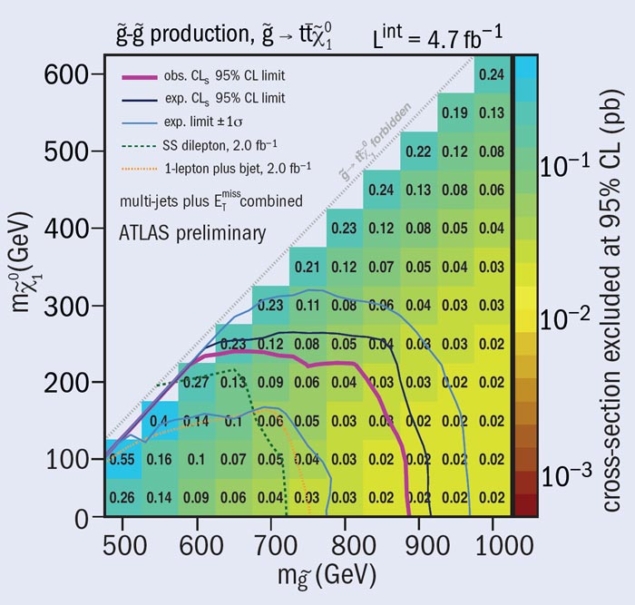Although no sign of supersymmetry (SUSY) has been observed so far, it is still the front-runner as a signal for new physics that could be discovered at the LHC. Not only does it neatly solve several shortcomings of the Standard Model, it also provides a candidate for the as-yet undiscovered dark-matter particle. Unfortunately, the masses of the SUSY particles are not constrained by theory, but it does provide some interesting hints. For SUSY to solve in a natural way the fine-tuning problems that arise in the Standard Model from the presence of a low-mass Higgs, the lightest of the two supersymmetric partners of the top quark (stop quarks) should have a mass not too much beyond that of the Standard Model counterpart, and the mass of the gluon’s superpartner (gluino) should not be too far above that of the stop quarks.
Both the ATLAS and CMS collaborations have made significant progress in searching for possibly light third-generation squarks (stop and sbottom), produced either directly or in the decays of gluinos, and first results based on the full data set recorded in 2011, equivalent to about 5 fb–1, have been released. CMS has presented a search for events containing multiple b-quarks and two leptons of the same charge, thus effectively eliminating most of the Standard Model backgrounds. ATLAS has released a novel interpretation of its updated multi-jet analysis, which explores events with up to nine high-transverse-momentum jets.

The figures show the current constraints that both collaborations are imposing on the gluino, pushing its allowed mass above 850 GeV in some cases. In addition, constraints from experiments at Fermilab’s Tevatron on direct sbottom pair-production have been extended by both ATLAS and CMS, and first results constraining direct production of stop in a simplified model of stop decays were recently presented by ATLAS. These are just appetizers for more results that will be released by both collaborations over the next few months.
The collaborations have also updated the more canonical searches that look for multiple energetic jets, the eventual presence of leptons and large missing transverse momentum – a striking signature for the presence of a dark-matter particle that escapes the detectors. Both collaborations invested a large effort in refining their analysis techniques, thus boosting their sensitivities. In certain SUSY scenarios, gluinos and squarks with masses below 1.4 TeV are now excluded.

Last, the large data set produced by the LHC in 2011 allowed the collaborations to begin exploring the electroweak sector of the SUSY particle spectrum with the study of multilepton final states. New and updated results have been released for many other SUSY decay signatures, including photons and τ leptons, and also in the context of searches for long-lived particles, disappearing tracks, and signatures without missing momentum, which are becoming increasingly interesting as possible ways to discover SUSY.
While no indications for the presence of supersymmetric particles have been found in the LHC collisions so far, the hunt continues and more results from additional search channels will appear in the coming months. Only a small part of the SUSY parameter space has been challenged by direct searches so far. Relatively light stops and gluinos are still allowed by the present data, and more dedicated searches will show if “natural SUSY” prevails. The increase of the LHC centre-of-mass energy to 8 TeV and the foreseen increase of data to be delivered in 2012 will open a new window to search for the presence of SUSY particles. Combined with the collaborations’ ever-growing experience and new analyses dedicated to specific signatures, this guarantees exciting developments during the rest of the year.
Further reading
ATLAS-CONF-2012–037.
CMS PAS SUS-11–020.





